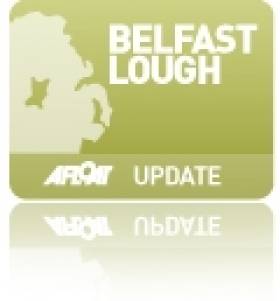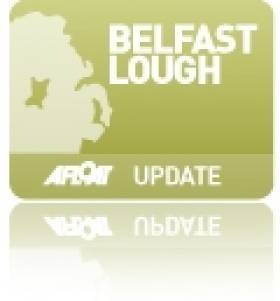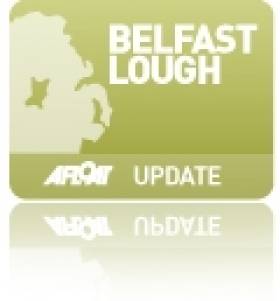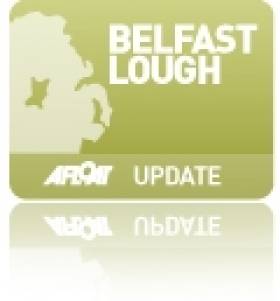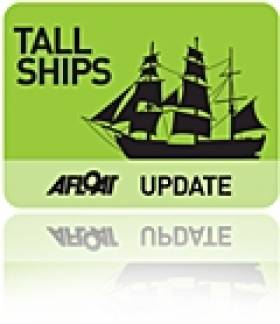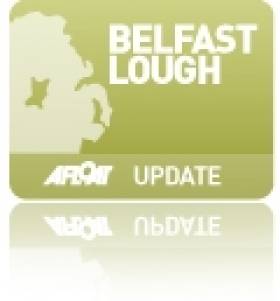Displaying items by tag: Belfast Lough News
#HMScaroline - The Belfast Telegraph writes on the count-down for the opening of HMS Caroline in Belfast's Titanic Quarter.
Following the award of a Heritage Lottery Fund grant of £11.5m and a further investment by Northern Ireland’s Department for Enterprise Trade and Investment, repairs to halt the deterioration of World War One light cruiser were completed earlier this year making the ship safe for the next stage of restoration.
Now the final leg of restoration and interpretative work can be completed to allow the ship to function as a world-class museum, a cross-community centre and a meetings and conferences venue.
National Museum of the Royal Navy Chief of Staff Captain John Rees OBE has been leading the complex funding and restoration programme in partnership with the Department for Enterprise, Trade and Investment.
To read more and for a list of key dates to held during the 2016 Opening schedule and over the course of the following year, click here.
Harland & Wolff Completes Rig 'Byford Dolphin' Contract
#RigContract -Harland and Wolff, Belfast has completed the dry docking and SPS Class Renewal Survey of the Byford Dolphin Mobile Offshore Drilling Unit (MODU) during the summer.
The offshore oil rig platform departed Belfast following a six-month dry docking in the ship yard's main Building Dock (556m x 93m) from where the iconic pair of the Samson & Goliath gantry cranes towered above the Byford Dolphin since arrival in January.
Harland and Wolff Director of Marine and Offshore Unit Repair, James Lappin, said "Over the years Harland and Wolff and Dolphin Drilling have collaborated on several occasions, having fabricated pontoons, column extensions, power generation and accommodation modules for other vessels in the Dolphin fleet."
RFA Argus Giant of the Waves Returns Home to Belfast
#NavyHospital - One the largest and most unusual military vessels in the world came home to Belfast for the weekend and where sea cadets had a tour, according to the Belfast Telegraph.
The RFA Argus (A135) will be a feature of the Belfast skyline until tomorrow (today,29 Sept), docked at Gotto Wharf on the Co Antrim side of the Lagan.
RFA Argus was originally an Italian container ship before becoming one of several taken from trade by the Ministry of Defence for use in the 1982 Falklands War.
She was utilised as an aircraft transport, ferrying aircraft on deck, before coming to Harland & Wolff in Belfast during 1985 to be converted into an aviation training ship.
The ship, which is recently back from service in Sierra Leone during the Ebola crisis as part of the Operation Gritrock response, will today (yesterday) welcome on board workers from Harland & Wolff who converted her 20 years ago.
For more on the homeport visit, click here.
Afloat.ie adds that the RFA Argus is registered in Belfast and is as a Primary Casualty Receiving Ship of the Royal Fleet Auxiliary service of the Royal Navy. A 100-bed medical complex can be uniquely tailored to deliver cutting-edge treatment afloat.
She has a flight deck where she can carry Merlin Mk2 helicopters and among the roles they are used for the UK’s Maritime Force Protection and airborne anti-submarine warfare capability for the foreseeable future.
RFA Argus has a gross tonnage of 18,820, a length of 175m and a crew of 80.
As for weapons she is equipped with a single Oerlikon 30mm gun, designed as a ship-protection system to defend Royal Navy frigates from various short range missiles, rockets, grenades and explosives.
In addition a hand operated mounting carrying a single Oerlikon KAA200 automatic cannon. This can fire 1000 rounds a minute and has a range of 2000m.
Belfast Harbour Hosts First Visit of New German Cruise Schiff 4
#NewCruiseVisitor – Belfast Harbour which expects 115,000 cruise-goers by end of season, welcomed a first time visitor this morning, the new Mein Schiff 4 which operates in the premium –German cruise market for TUI Cruises, writes Jehan Ashmore.
Mein Schiff 4 made the short overnight passage to Belfast from Greenock on the Clyde as part of an 11-day round trip cruise from Hamburg. She docked on the south bank downriver of the iconic H&W dockyards and neighbouring Titanic Quarter which has proved global visitor attraction appeal. Last year, Belfast Harbour achieved a record total of 114,000 cruise passengers.
The $625m newbuild of 99,500 tonnes was completed in late 2014 and is the second of series built in Finland. In fast she was completed only two days after the STX Finland Oy’s yard in Turku was taken over by German-owners to form the Meyer Turku yard in south-west Finland. She began her career carrying out several cruises last month to Baltic and Scandinavian capitals.
Since the introduction of the 15 deck cruiseship catering for the German-speaking market, Mein Schiff 4 (clearly translating to ‘My Ship 4’) has boosted TUI’s fleet passenger total to 6,342 berths.
She has a capacity for 2,506 passengers accommodated in 1,253 cabins in which 90% are outside and 82% feature cabins. Of those equipped with cabins, they are up to24 m² in size. In all, the newcomer offers 23 categories, which demonstrates a wide choice in the cruise industry.
Among her facilities are 11 restaurants and bistros, 11 bars and lounges. Among her recreational options, there’s a basketball course and sea views which can be seen from saunas.
She also boasts a first for the cruise industry, a 25m long swimming pool located on Deck 12. Elsewhere, is an indoor pool with a whirlpool when the weather is less favourable.
This evening Mein Schiff sets sail on a southbound course for Dun Laoghaire Harbour as previously reported on Afloat.ie where the new cruiseship is to anchor tomorrow offshore and bring passengers ashore by tender craft.
TUI Cruises was formed in 2008 in a joint venture between TUI AG and Royal Caribbean Ltd. The final sister in the newer ‘Mein Schiff’ series is due for delivery in 2019.
#StrongGrowth - Against the backdrop of 500,000 visitors to Belfast's Tall Ships Festival in the port area, Belfast Harbour has reported record profits and turnover, and committed to invest £120 million in new infrastructure projects over the next three years.
Figures detailed in the Harbour's 2014 annual report revealed that turnover increased 4% to £52.6 million whilst Profits before Tax climbed 8% to a record £29.4 million. The Harbour also paid a record £10 million in tax during the year.
The performance was supported by growth in the volume of trade through the Harbour, with particularly strong performances in the freight traffic sector, up 2.2% to 476,000 vehicles and bulk cargoes such as coal and animal feed which brought dry bulk trade to over seven million tonnes for the first time.
In the past five years the Harbour has invested £100 million in new projects to enhance its infrastructure and services to Port customers and to maintain competitiveness with other ports across the island of Ireland. Projects in the pipeline include an upgrade of the Harbour's Roll-On/Roll-Off facilities, enhanced container handling capability and Cruise ship facilities.
Commenting on the results David Dobbin, Belfast Harbour's Chairman, said: "Belfast Harbour has successfully come through the global recession by investing heavily to diversify its business activities and to improve the competitiveness of its operations.
"Although growth in trade has slowed over the past year, the total throughput through the Port at 23 million tonnes is now 47% above low point of the recession in 2009. There is, however, little room for complacency given the fragile nature of the recovery and the negative impact which a stronger sterling is having upon local exporters.
"The Harbour's strategy of long-term investment for long-term growth has served us well. This will continue through a pipeline of capital expenditure projects totaling £120 million. Projects include a bespoke cruise facility and addressing the continuing shortage of Grade A office accommodation in Belfast by further developing the City Quays scheme. Last week the Board approved a £20 million spend on the City Quays 2 building."
During 2014 the Harbour commenced work on City Quays 1, the first office building in its City Quays development. With that building now complete and legal firm Baker & McKenzie secured as the anchor tenant, work will begin soon on the next stage of the development, City Quays 2, providing a further 124,000 sq ft of office accommodation.
Upon final completion the £250 million, 20-acre City Quays scheme is expected to support 10,000 jobs and generate £11 million in rates income for local and central Government.
Dr. Dobbin added: "As an entirely self-funded business with no recourse to the public purse or private finance, there is a clear linkage between the Harbour's ability to invest and grow, and its financial performance.
"Every penny of the Harbour's earnings are retained within the business and reinvested to develop Port facilities and real estate, creating much needed jobs and driving regional development. This year's record financial performance gives the Harbour a strong basis from which to support future growth.
"Belfast Harbour is an integral part of the life and economy of Northern Ireland, as demonstrated by the 500,000 visitors anticipated at this weekend's Tall Ships Festival. The public has a keen interest in Belfast's maritime heritage and with £120 million earmarked for new projects the Harbour has demonstrated its commitment to the Harbour's future."
Other developments during 2014 included the enhancement of quay facilities at Pollock Dock to support increased waste and recycling related tonnages, and the award of planning approval to develop up to 200,000 sq ft of business space within Sydenham Business Park.
Belfast’s £5m Lagan Weir Bridge Opens
#NewLaganBridge - A new bridge across the River Lagan in Belfast reports UTV News has been opened by Social Development Minister Mervyn Storey MLA.
Connecting Donegall Quay with Queen's Quay the new Lagan Weir Pedestrian and Cycle Bridge replaces the old footbridge and represents a £5m investment in the city from the department.
Speaking at the official opening, Minister Storey said, "I am delighted to officially open the new Lagan Weir pedestrian and cycle bridge.
"This magnificent bridge considerably improves the connection from Belfast city centre to Queen's Quay, and showcases the potential for development in this area."
With 16,000 people crossing the old footbridge each week, it is anticipated that the new Bridge will be well utilised, offering access - for the first time - to both pedestrians and cyclists.
The Minister added: "My department is committed to implementing the Queen's Quay Masterplan and this is the first stage in that process.
"The Queen's Quay Masterplan sets out an exciting vision of the development potential of this area, and the creation of this new bridge will improve the links between the city centre and Queen's Quay, as well as the Titanic Quarter."
The new bridge, which is approximately eight metres across at its widest point, was constructed by Graham Construction and has been completed in time for the Tall Ships 2015 event.
Afloat.adds this is the third time Belfast City has hosted the Tall Ships Race where more than 50 tall ships will be visiitng the harbour for a four-day festival beginning tomorrow, Thursday (2 July).
For more on this new bridge spanning the Lagan, click here.
In the Black As H&W Post Pre-Tax Profit of £8.7m
#H&Wprofits – Returning to the black as Harland & Wolff have posted pre-tax profits of £8.7m following huge losses just a year earlier.
The Belfast shipyard clawed back its profits by opening up business across a range of areas after its more than £4m losses in 2013, Harland & Wolff has said.
Turnover for the year ending December 2014 shot up to £55m - a 70% rise on the same period in 2013, when it stood at £32m.
Harland & Wolff's sales and marketing manager David McVeighsaid the increase was down to "continual investment" in the firm, and moving on from the huge loss it suffered in 2013.
For more on this story, The Belfast Telegraph has a report here.
#OilRigFire – An evacuation of more than 300 factory workers had to be carried out from an oil rig at Harland and Wolff after a small fire broke out during welding operations.
Harland and Wolff said local emergency services were very quickly on hand - however the fire had already been extinguished by H&W Fire Watch on board.
A spokesman said: "We would like to thank the Northern Ireland Fire & Rescue Service for their rapid response and professionalism.
The Northern Ireland Fire and Rescue Service received the call at around 1.45pm and had brought the fire under control by 4pm.
For more The Belfast Telegraph has a report here.
50 Days to Go Until Tall Ships Arrive on Belfast Lough
#BelfastTallShips – As of today, there are exactly 50 days to go until 50 of the world's finest Tall Ships begin to arrive on Belfast Lough.
Belfast Harbour will act as the home port before the start of the 2015 Tall Ships Race, with dozens of the world's majestic sailing vessels berthed in city over the weekend of July 2–5.
This is the third time that Belfast has welcomed the Tall Ships Race, having previously staged the event in 1991 and 2009. However, with the city acting as the staging post for the first leg of the race, even more ships will be taking part this year, with some 50 vessels – including 18 massive Class A ships – making the port their home for four days before setting off on their annual challenge.
More than 500,000 people are expected to attend the free event, bringing with them an economic windfall of at least £10 million for the city.
For further information on the events taking place over the weekend, the ships and where they will be berthed, the ancillary entertainments' programme, park and ride facilities and so on.
For info visit www.tallshipsbelfast.com
Art Exhibition Explores Life of Harland & Wolff Docker
#Art@TitanicBelfast - Titanic Belfast will be of special interest to anyone with family connections to Harland and Wolff Shipyard as there is a solo art exhibition underway.
Entitled 'Queen's Island, the ships and the people', it features around 50 paintings done by local artist Eddie Millar and runs (in the iconic visitor attraction's) Andrews Gallery until May 10.
Eddie explained that all of the work featured has been done in the last three years.
"Most of my family have worked in the Shipyard at some stage. My father worked there for 36 years and my brother for a similar length of time.
For more The Belfast Telegraph features the exhibition along with a video report (click HERE) taken from the exhibition.


























